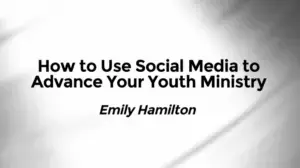Today Emily Hamilton joins us to talk about “How To Use Social Media to Advance Your Youth Ministry”.
Emily serves as the ministry assistant to the church and missions development director for the Etowah Baptist Association.
There are a lot of different ways we can use social media, but there is a way that it can fit with you and what you’re doing. So I hope that we can discover ways that you can do social media really well within the context of your group.
The first step to using social media well at your church and in your setting is to prepare and equip your students to use social media. We have to teach our students to make wise decisions. Andy Stanley says in his podcast series, The Best Question Ever, that a lot of times we don’t ask the right question. We ask ‘What can we do?’ or ‘What can we get away with?’ but he says the right question that we should be asking is, ‘What is wise?’ He puts it this way, he says, ‘In light of my past experiences, my current circumstances and my future aspirations what is the wise thing to do?’ So how do we make students think this way? That can be really difficult.
The Center for Parent/Youth Understanding is a fantastic resource for parents and youth leaders to help them understand what media is like for their youth. Walt Mueller of CPYU has written a resource about three steps we can take to help our students make wise decisions. Step one is that they need to discover what the media is trying to teach them, the worldview that the media is trying to put into their lives. Step two is learning what can we discern about ourselves through this media. Is this media good for us? And the last step is to decide whether we want this in our lives or not. There are some really practical ways to help your teens make those decisions. It’s really important that we help them to make wise media decisions because later on, you’re going to learn that they’re really crucial in using social media well within your own ministry.
The second thing we can do to use media well in our ministry is to make wise decisions ourselves. We as ministers, most of us didn’t grow up with social media. I had my first Facebook page when I was probably in my senior year of high school and you could only be friends with people who were in your network. So it was a lot different. It was vastly different than what our students have now and so we have to be a picture of wise decisions. We have to use our own personal social media accounts as ways to spread the gospel and encourage other believers. We have to keep the junk off. We have to keep the articles and the posts and the stuff that takes away or distracts from the gospel away from our own personal accounts and we have to show students how to use it wisely. They are watching us.
The third thing and probably the most important thing that we can do to use social media wisely in our ministry is to equip our students. We have to know them. We have to know everything about them. We have to know what they’re involved in, what their interests are and what media they’re using. A friend of mine says it this way, “We want to be intimately involved in every area of their lives,” and that includes their social media and their social media choices.
For some of you, that means learning how to post an announcement on Snapchat via a Snapchat story. For some of you ladies, it might mean getting on Pinterest and creating a group of girls that like to do arts and crafts and posting things that they might like to do together with you or you that a volunteer in your church could do with them. For some of you, it means just spending a little bit more time on your Instagram posts and making them more visually appealing. There are ways that you can meet the needs of your students but you must know them first. Equip them to make wise media decisions and then allow them to lead out in that area in your ministry. Allow them opportunities to say “This is what my friends are using, this is what I want to use. Let’s do it together.”
I want to point out first that Facebook is not the primary social media tool that students are using right now. Your primary audience for Facebook is going to be your parents but that’s still important. A good way to use Facebook is by creating groups. That way we can target our information to the people we want it to get to, and there are a lot of apps we can do that with. We can do that with a Facebook group, we can do it with GroupMe – there are a lot of different ways we can do that. But when you get your target audience down use as few words as possible. Students don’t want to be bombarded with a huge post. They want to see just a few words. I recently posted two posts about the same event and one of them had very few words and one of them had a paragraph. Which event do you think more students attended? It was definitely the one with few words. They wanted to come to something that intrigued them immediately without having to read a paragraph.
A second example I want to give you also comes from Facebook and the benefit of using a Facebook page, not a profile. Having a Facebook page allows you to feed into their newsfeed on a regular basis and to inhabit what gets posted on there. So you are completely in charge. It’s an open group; no one has to ask to join it. Anyone can follow you at any time. I recently announced an event with two posts. One of them reached eleven people. The next one reached 96 people. These were posts about the same exact event. So guess what the difference was? The second post had a picture. Pictures always draw more attention than words.
That brings us to our final point which is about using Instagram. Sometimes I use what I like to call story-telling pictures and some are simply announcement pictures. Always, always, always post with as few words as possible on a picture rather than text. There are great apps for that like Over and Pic App. There are a lot of great things you can do to post those words over the top of a picture that are fantastic.
When it comes to story-telling pictures I want you to think about two things. Number one: do you have permission to post this student’s picture? And number two: what is your story that you are telling? Are you going to post a picture about baptisms and outreach or are you going to post pictures of people eating dinner and going out to to the movies? Think about what story you’re telling, equip your students to tell it, and tell it in a way that’s going to reach them.
Source: YMLink.org
How To Use Social Media to Advance Your Youth Ministry






